Physics - Ch 66 Ch 4 Quantum Mechanics: Schrodinger Eqn (90 of 92) A High Energy Proton
TLDRThe lecture explores the probability of a 20 MeV proton penetrating a high potential barrier of varying widths, from 1 to 5 femtometers. The transmission coefficient calculations reveal that the probability drops dramatically as the barrier width increases, with the chance of passing through falling from 0.56 for a 1 femtometer barrier to less than 1 in a million for a 5 femtometer barrier. This illustrates the rapid diminishment of a particle's likelihood to traverse a widening barrier.
Takeaways
- 🔬 A 20 MeV proton is attempting to pass through a barrier with a potential of 40 MeV.
- 🧬 The barrier widths vary from 1 to 5 femtometers, which is in the order of the radius of a nucleus.
- 🚀 The transmission coefficient (probability) of the proton passing through the barrier is calculated using the formula T = 4 * e^(-2αL), where α is a large number due to the proton's mass and energy.
- 📉 The probability of the proton passing through the barrier decreases exponentially as the barrier width increases.
- 🌟 For a 1 femtometer wide barrier, the probability is approximately 0.56, which is slightly over 1/2.
- 📉 When the barrier width doubles to 2 femtometers, the probability drops to 0.08.
- 📉 At 3 femtometers, the probability further decreases to about 0.01 or 1%.
- 📉 For a 4 femtometer barrier, the probability drops to less than one in a million.
- 📉 At the 5 femtometer width, the probability is extremely small, approximately 2.2 * 10^(-4).
- 💡 The alpha value is crucial in determining the transmission probability, with a higher alpha leading to a higher initial probability.
- 🌐 The concept demonstrates the quantum tunneling effect and how it diminishes with increasing barrier widths and insufficient energy.
Q & A
What is the energy level of the proton mentioned in the lecture?
-The proton has an energy level of 20 MeV (million electron volts).
What is the potential barrier the proton is trying to pass through?
-The proton is trying to pass through a barrier with a potential of 40 MeV (million electron volts).
What is the range of widths for the barrier being considered?
-The barrier widths considered range from 1 femtometer to 5 femtometers, which is in the order of the radius of a nucleus.
How does the width of the barrier affect the probability of the proton passing through?
-As the width of the barrier increases, the probability of the proton passing through decreases drastically.
What is the calculated transmission coefficient (probability) for the proton passing through a 1 femtometer wide barrier?
-The transmission coefficient for a 1 femtometer wide barrier is approximately 0.56 or 56%.
What is the transmission coefficient for the proton passing through a 2 femtometer wide barrier?
-The transmission coefficient for a 2 femtometer wide barrier is 0.08 or 8%.
What is the formula used to calculate the transmission coefficient?
-The formula used is T = 4 * e^(-2 * alpha * L), where T is the transmission coefficient, alpha is a constant, and L is the width of the barrier.
What is the value of alpha used in the calculations?
-The value of alpha used in the calculations is 9.8 * 10^14.
How does the mass of the particle affect the transmission probability?
-The mass of the particle affects the value of alpha, which in turn affects the transmission probability. A smaller mass, like that of an electron, results in a smaller alpha and thus a different rate of drop in transmission probability.
What happens to the probability as the width of the barrier increases beyond 1 femtometer?
-The probability drops off very quickly as the width of the barrier increases beyond 1 femtometer, indicating that the proton is much less likely to pass through wider barriers.
What is the transmission coefficient for the proton passing through a 5 femtometer wide barrier?
-The transmission coefficient for a 5 femtometer wide barrier is approximately 2.2 * 10^(-4) or 0.00022, which is a very small probability.
Outlines
🔬 Quantum Tunneling and Barrier Penetration
This paragraph discusses a theoretical scenario where a high-energy proton with 20 MeV is attempting to pass through a barrier with varying widths, starting from 1 femtometer to 5 femtometers, which is in the order of the radius of a nucleus. The barrier's potential is much higher than the proton's energy, set at 40 MeV. The lecture introduces the concept of alpha, a large number representing the ratio of the proton's mass and energy, which is calculated to be 9.8 x 10^14. The transmission coefficient, representing the probability of the proton getting through the barrier, is derived and calculated for each width of the barrier. It is shown that as the barrier width increases, the probability of the proton passing through decreases exponentially, with a significant drop from 0.56 for a 1 femtometer barrier to 0.01 (1%) for a 3 femtometer barrier, and further diminishing to less than one in a million for a 5 femtometer barrier. This illustrates the rapid decrease in the likelihood of quantum tunneling as the barrier width increases.
🧠 Re-evaluating Quantum Tunneling Probabilities
The speaker acknowledges a potential mistake in the previous calculation and revisits the quantum tunneling probabilities for a proton passing through a barrier of varying widths. The focus is on correcting the calculation for the probability when the barrier width is 5 femtometers. The corrected probability is found to be 2.2 x 10^-4, which is still very small but not as tiny as initially thought. The speaker emphasizes that the probability of a proton passing through a barrier drops to virtually zero as the barrier width increases significantly, providing insight into the behavior of quantum particles and the limitations of their energy in overcoming such barriers.
Mindmap
Keywords
💡High-energy proton
💡Quantum tunneling
💡Potential barrier
💡Femtometer
💡Transmission coefficient
💡Alpha (α)
💡Electronvolt (eV)
💡Conversion to joules
💡H-bar (ħ)
💡Exponential function
💡Probability
Highlights
A high-energy proton is attempting to pass through a barrier with high potential.
The proton has an energy of 20 MeV (million electron volts).
The barrier's potential is 40 MeV, significantly higher than the proton's energy.
The barrier widths vary from 1 to 5 femtometers, comparable to the radius of a nucleus.
The transmission coefficient (probability) of the proton passing through the barrier is calculated using a specific formula.
The alpha value, a significant factor in the calculation, is found to be 9.8 x 10^14.
As the barrier width increases, the probability of the proton passing through decreases exponentially.
For a barrier width of 1 femtometer, the probability is 0.56, slightly over 1/2.
Doubling the barrier width to 2 femtometers reduces the probability to 0.08.
At a barrier width of 3 femtometers, the probability drops to approximately 0.01%.
For a 4 femtometer barrier, the probability is less than one in a million.
At the widest barrier of 5 femtometers, the probability is calculated to be 2.2 x 10^-4.
The mass and energy of the proton play a crucial role in its ability to pass through the barrier.
An electron would have a much higher probability due to its smaller mass and larger alpha.
The lecture provides a clear demonstration of quantum tunneling and its dependence on particle mass and barrier width.
The rapid decrease in probability with increasing barrier width illustrates the sensitivity of quantum phenomena to physical dimensions.
The lecture's calculations and findings are valuable for understanding the behavior of particles at the quantum level.
Transcripts
Browse More Related Video
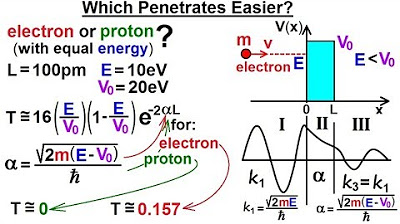
Physics - Ch 66 Ch 4 Quantum Mechanics: Schrodinger Eqn (89 of 92) Which Penetrates Easier?
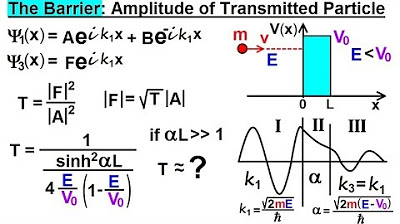
Physics - Ch 66 Ch 4 Quantum Mechanics: Schrodinger Eqn (78 of 92) The Barrier: Amplitude
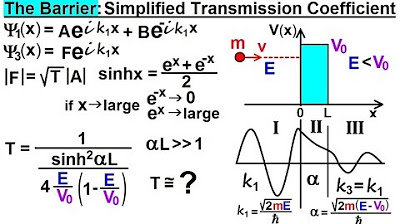
Physics - Ch 66 Ch 4 Quantum Mechanics: Schrodinger Eqn (79 of 92) Simplified Transmission Coeff.
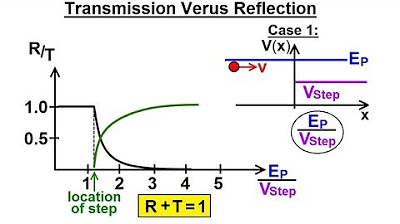
Physics - Ch 66 Ch 4 Quantum Mechanics: Schrodinger Eqn (62 of 92) Transmission vs Reflection
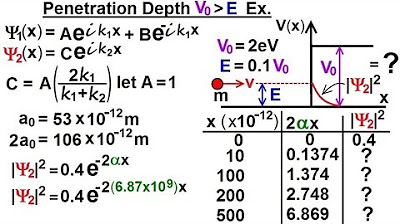
Physics - Ch 66 Ch 4 Quantum Mechanics: Schrodinger Eqn (76 of 92) Penetration Depth V0, E: Ex.
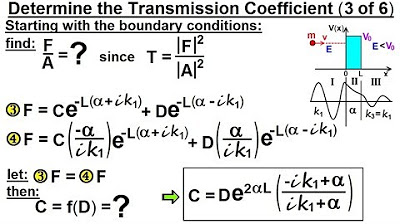
Physics - Ch 66 Ch 4 Quantum Mechanics: Schrodinger Eqn (85 of 92) Transmission Coeff=? (3 of 6)
5.0 / 5 (0 votes)
Thanks for rating: